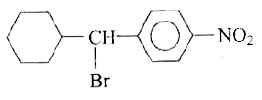The rate of Snl reaction is fastest with :




The correct Answer is:A
To determine which compound has the fastest rate of an SN1 reaction, we need to analyze the stability of the carbocation that forms during the reaction. The rate of an SN1 reaction is directly proportional to the stability of the carbocation intermediate. Here’s a step-by-step solution:
Step 1: Understand the SN1 Mechanism
The SN1 reaction involves the formation of a carbocation intermediate after the leaving group departs. The stability of this carbocation is crucial for the reaction rate.
Hint: Remember that the more stable the carbocation, the faster the SN1 reaction will occur.
Step 2: Identify Factors Affecting Carbocation Stability
Carbocation stability is influenced by:
- Resonance: Stabilization through delocalization of charge.
- Hyperconjugation: Stabilization through the overlap of σ-bonds with the empty p-orbital of the carbocation.
- Inductive Effect: Electron-donating groups stabilize carbocations, while electron-withdrawing groups destabilize them.
Hint: Look for groups that can stabilize the carbocation through resonance or hyperconjugation.
Step 3: Analyze Each Option
1. Option 1: Contains a bromine leaving group and a structure that allows for resonance stabilization of the carbocation.
2. Option 2: Has a nitro group (-NO2) which is an electron-withdrawing group, destabilizing the carbocation.
3. Option 3: Similar to option 1 but with a different structure that may not allow for effective resonance.
4. Option 4: Contains an aromatic ring that may also destabilize the carbocation due to resonance.
Hint: Compare the ability of each structure to stabilize the carbocation formed after the leaving group departs.
Step 4: Compare the Stability of Carbocations
- Option 1: The carbocation formed can be stabilized by resonance from adjacent double bonds or groups.
- Option 2: The nitro group destabilizes the carbocation due to its -M effect.
- Option 3: Less effective resonance stabilization compared to option 1.
- Option 4: The aromatic ring does not stabilize the carbocation effectively.
Hint: Identify which option provides the most resonance stabilization for the carbocation.
Step 5: Conclusion
After analyzing the stability of the carbocations formed from each option, it is clear that Option 1 provides the most stable carbocation due to effective resonance stabilization. Therefore, the rate of the SN1 reaction is fastest with Option 1.
Final Answer: The rate of SN1 reaction is fastest with Option 1.
The SN1 reaction involves the formation of a carbocation intermediate after the leaving group departs. The stability of this carbocation is crucial for the reaction rate.
Carbocation stability is influenced by:
- Resonance: Stabilization through delocalization of charge.
- Hyperconjugation: Stabilization through the overlap of σ-bonds with the empty p-orbital of the carbocation.
- Inductive Effect: Electron-donating groups stabilize carbocations, while electron-withdrawing groups destabilize them.
1. Option 1: Contains a bromine leaving group and a structure that allows for resonance stabilization of the carbocation.
2. Option 2: Has a nitro group (-NO2) which is an electron-withdrawing group, destabilizing the carbocation.
3. Option 3: Similar to option 1 but with a different structure that may not allow for effective resonance.
4. Option 4: Contains an aromatic ring that may also destabilize the carbocation due to resonance.
- Option 1: The carbocation formed can be stabilized by resonance from adjacent double bonds or groups.
- Option 2: The nitro group destabilizes the carbocation due to its -M effect.
- Option 3: Less effective resonance stabilization compared to option 1.
- Option 4: The aromatic ring does not stabilize the carbocation effectively.
After analyzing the stability of the carbocations formed from each option, it is clear that Option 1 provides the most stable carbocation due to effective resonance stabilization. Therefore, the rate of the SN1 reaction is fastest with Option 1.
Similar Questions
Knowledge Check
SN1 reaction is fastest in
ACH3CH2BrBCH3−CH∣Cl−CH3CCH3−CH3C∣∣CH3−ClDCH3−CH∣CH2∣CH3−ClAssertion : The rate of reaction is the rate of change of concentration of a reactant or a product.
Reason : Rate of reaction remians constant during the complete reaction.AIf both assertion and reason are true and reason is the correct explanation of assertion.BIf both assertion and reason are true but reason is not the correct explanation of assertion.CIf assertion is true but reason is false.DIf both assertion and reason are false.
The reaction,

is fastest when X is :
View SolutionCH3−O∣∣C−CH3X2−−→OHɵCHX3+CH3−O∣∣C−Oɵ
The rate of haloform reaction reaction is fastest with
View SolutionRate of the reaction is fastest when Z is -

View SolutionIf the rate of the reaction is equal to the rate constant, the order of the reaction is
View SolutionIn the reaction A+B→C+D, the concentration of A and B are equal and the rate of the reaction is rate =k[A][B]. The integrated rate equation for this reaction is
View SolutionThe rate constant of a reaction is equal to the rate of reaction when
View Solution
